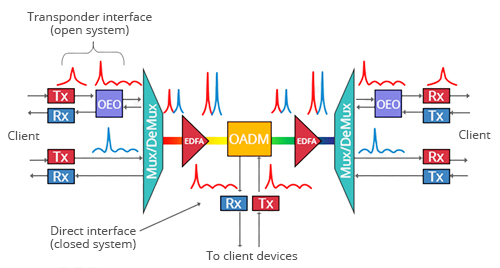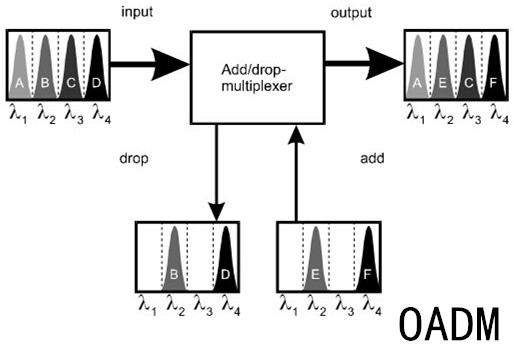The explosive growth of Internet use and various applications of large bandwidth have increased the demands of information-carrying capacity in optical data transmission. DWDM, based on WDM (wavelength-division multiplexing) technology, has been developed to satisfy these demands. And this post gives a brief introduction of three main components in a DWDM system: MUX, DEMUX and OADM.
DWDM (dense wavelength-division multiplexing) is a technology that puts data from different sources together on an optical fiber, with each signal carried at the same time on its own separate light wavelength. It allows several optical channels to occupy a single fiber optic cable and greatly increases the transmission bandwidth by multiplexing the capacity of a single-mode fiber. In a DWDM system, high demands are placed on its components, such as multiplexer, demultiplexer and optical add and drop multiplexer. When coupled those components, a DWDM system can play an important role in optical management networks, in which a DWDM multiplexer and a DWDM demultiplexer are used to combine and split wavelength channels at standard ITU grid, and an OADM is used to drop and add bit streams of a specific wavelength. The following figure shows a complete DWDM system.
DWDM multiplexer (MUX) contains a wavelength-converting transponder for each data signal. Each wavelength-converting transponder receives an optical data signal from the client-layer, such as Synchronous optical networking [SONET /SDH] or another type of data signal, converts this signal into the electrical domain and re-transmits the signal at a specific wavelength using a 1,550 nm band laser. These data signals are then combined together into a multi-wavelength optical signal using an optical multiplexer, for transmission over a single fiber.
In fact, multiplexers and demultiplexers are identical components and should be deployed in DWDM systems together, except for one aspect that they are placed in the opposite direction just shown in the above figure. This means that the DWDM demultiplexer (DEMUX) separates the multi-wavelength optical signal received from the optical multiplexer back into individual data signals and outputs them on separate fibers for client-layer systems (such as SONET/SDH).
Multiplexers, demultiplexers and optical add and drop multiplexers all are necessary components in DWDM systems while meeting the greater transmission demands in optical networks. Fiberstore supplies a series of qualified DWDM MUX, DWDM DEMUX and DWDM OADM modules, such as 40 channel DWDM Mux. In addition, other DWDM modules like DWDM SFP Cisco are also available in Fiberstore. You can visit Fiberstore for more information about DWDM modules.

